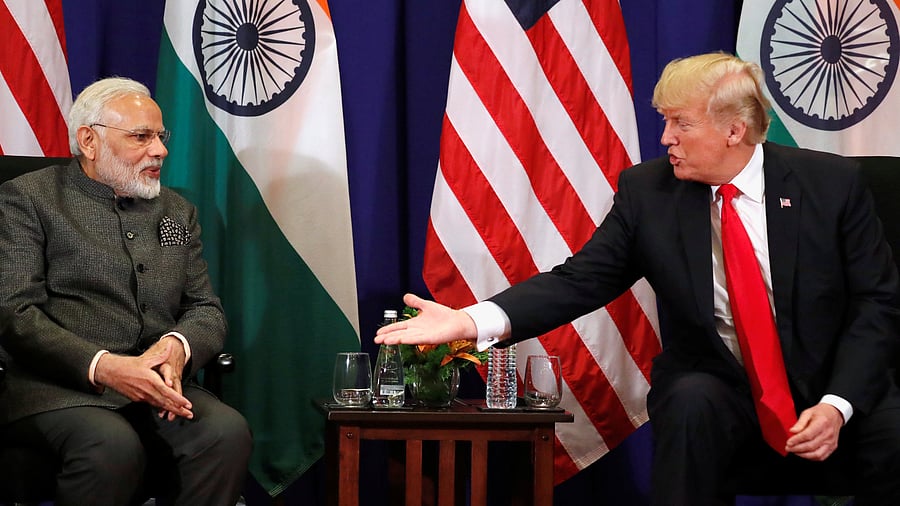
PM Narendra Modi (L) and US President Donald Trump (R).
Credit: Reuters File Photo
By Andy Mukherjee
Washington has taken its brinksmanship against New Delhi to a dangerous level. Doubling an already-high tariff of 25 per cent is bad enough. What makes it worse for Prime Minister Narendra Modi is the language. President Donald Trump has decided to call India’s additional punishment for importing Russian oil a “secondary” tariff, a made-up term that has a close cousin in the world of sanctions.
Secondary sanctions impose a cost on third parties for allegedly enabling bad behavior by someone else. If a US bank, port, ship, or company is prohibited from engaging in a transaction involving the Russian financial system, then a secondary sanction can make it potentially illegal for non-Americans, too.
New Delhi should be wary. The goal of the punitive tax is to get Russian President Vladimir Putin to end the Ukraine War. If that objective is not realized, there’s no guarantee of what the White House might do next to the world’s biggest buyer of seaborne Russian crude.
A sanction masquerading as tariff is just Trump being innovative. A more conventional tool is the Specially Designated Nationals list, maintained by the Office of Foreign Assets Control in the US Treasury.
State-owned Indian refiners are already pulling back from the Russian trade. If they start showing up on the SDN list, it would become difficult for others to do business with them. No amount of nationalistic bluster can mitigate the seriousness of that threat. To lose access to the US currency or the Western-controlled banking system would be a far bigger setback than a 50 per cent tariff. Even large Indian tycoons will not want to needle Trump. Russian crude has been the biggest source of oil for Mukesh Ambani’s refinery this year. His rival billionaire Gautam Adani doesn’t have any exposure to oil, but he has existing legal trouble with the US government. He also has a vast port network to protect.
What’s the way out then? In an interview with Reuters, Brazilian President Luiz Inacio Lula da Silva, who’s also been handed penal tariffs of 50 per cent, floated a trial balloon: a joint response by BRICS. Modi, who spoke on the phone with Lula for nearly an hour Thursday, is expected to head to China this month — for the first time in seven years. Marshaling a unified front to challenge Trump’s overreach might make sense to Lula, but ratcheting up the confrontation with Washington should hold no appeal for Modi.
Brazil’s biggest export market is China, with whom it has a $49 billion trade surplus. India, on the other hand, sells just about $32 billion annually to Brazil, Russia and China — combined. The US buys nearly three times as much from it, in addition to providing tens of thousands of work visas each year to Indian techies. Washington also controls the student-visa pipeline for — amongst others — children of local politicians, bureaucrats, tycoons and bankers. Even if Modi wants to go on a collision course with Trump, the elite wouldn’t let him.
Team Modi must switch its focus. What started off as a US-China trade and technology war has turned into a much bigger play for absolute American dominance. There is no point now in negotiating a discount on the 25 per cent reciprocal tariff. Let that be handled as part of a broader trade deal. Getting the secondary tax cancelled in Trump’s three-week grace period has to be the more immediate goal.
Even if Modi succeeds in that limited objective, his political opponents won’t let him run a victory lap. “India, please understand: The reason PM Modi cannot stand up to President Trump despite his repeated threats is the ongoing US investigation into Adani,” Rahul Gandhi, leader of the opposition in parliament, wrote in a post on X. He went on to say that Modi’s hands are tied by AA. Gandhi, who often questions the outsize economic dominance of Ambani and Adani, refers to them in shorthand as AA — or A1 and A2.
Adani, the infrastructure czar, is facing criminal charges in the US for his alleged role in what the Department of Justice has described as a $250 million bribery scheme involving a solar-energy contract. The Adani Group has refuted the allegations as baseless and said it’s fully compliant with all laws. It also denied a Wall Street Journal article in June that said that US prosecutors are investigating whether Adani's companies imported Iranian liquefied petroleum gas, or LPG, into India through his flagship Mundra port, violating sanctions.
The businessman from Modi’s home state of Gujarat also denies receiving any favors from the government because of his long association with the prime minister. During his visit to the White House in February, Modi, who doesn’t comment on Adani at home, described the tycoon’s legal troubles as a “personal matter” that doesn’t belong to discussions between national leaders. This week, Adani stepped back from his role as executive chairman of the port business, which controls Israel’s Haifa terminal and is looking to expand in Europe. The company said the transition to a non-executive role, in which Adani will no longer count among key management personnel, was to ensure compliance with corporate governance norms. It “was long planned.”
The secondary tariff is just Trump-speak for a display of America’s power over non-Americans. Ambani’s oil-refining business is trying to diversify away from Russia, One of his units has paid a $10 million “development fee” to the president’s real-estate firm, licensing the Trump name in Mumbai, according to the WSJ.
There is no other option. Trade disputes can still be taken to the World Trade Organization. In the realm of sanctions, might is the only rule — and the dollar the only currency. The likes of Lula and Modi can protest the former as much as they want, but no savvy businessman in their countries can do without the latter.